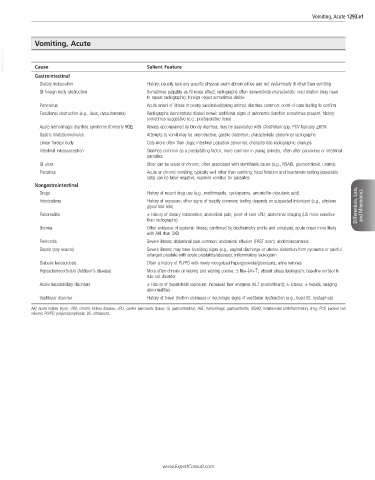Page 2565 - Cote clinical veterinary advisor dogs and cats 4th
P. 2565
Vomiting, Acute 1293.e1
Vomiting, Acute
VetBooks.ir Cause Salient Feature
Gastrointestinal
Dietary indiscretion History; usually lack any specific physical exam abnormalities and not systemically ill other than vomiting
GI foreign body obstruction Sometimes palpable as GI mass effect; radiographs often demonstrate characteristic orad dilation (may need
to repeat radiographs); foreign object sometimes visible
Parvovirus Acute onset of illness in poorly vaccinated/young animal; diarrhea common; point-of-care testing to confirm
Functional obstruction (e.g., ileus, dysautonomia) Radiographs demonstrate dilated bowel; additional signs of autonomic function sometimes present; history
sometimes suggestive (e.g., postoperative ileus)
Acute hemorrhagic diarrhea syndrome (formerly HGE) Always accompanied by bloody diarrhea; may be associated with Clostridium spp; PCV typically ≥60%
Gastric dilatation/volvulus Attempts to vomit may be unproductive; gastric distention; characteristic abdominal radiographs
Linear foreign body Cats more often than dogs; intestinal palpation abnormal; characteristic radiographic changes
Intestinal intussusception Diarrhea common as a precipitating factor; more common in young animals, often after parvovirus or intestinal
parasites
GI ulcer Ulcer can be acute or chronic; often associated with identifiable cause (e.g., NSAID, glucocorticoid, uremia)
Parasites Acute or chronic vomiting; typically well other than vomiting; fecal flotation and heartworm testing (especially
cats) can be false-negative; examine vomitus for parasites
Nongastrointestinal
Drugs History of recent drug use (e.g., methimazole, cyclosporine, amoxicillin-clavulanic acid)
Intoxications History of exposure; other signs of toxicity common; testing depends on suspected intoxicant (e.g., ethylene
glycol test kits) Differentials, Lists, and Mnemonics
Pancreatitis ± History of dietary indiscretion; abdominal pain; point-of-care cPLI; abdominal imaging (US more sensitive
than radiographs)
Uremia Other evidence of systemic illness; confirmed by biochemistry profile and urinalysis; acute onset more likely
with AKI than CKD
Peritonitis Severe illness; abdominal pain common; abdominal effusion (FAST scan); abdominocentesis
Sepsis (any source) Severe illness; may have localizing signs (e.g., vaginal discharge or uterine distention from pyometra or painful
enlarged prostate with acute prostatitis/abscess); inflammatory leukogram
Diabetic ketoacidosis Often a history of PU/PD with newly recognized hyperglycemia/glucosuria; urine ketones
Hypoadrenocorticism (Addison’s disease) More often chronic or waxing and waning course; ± Na+↓K+↑; absent stress leukogram; baseline cortisol to
rule out disorder
Acute hepatobiliary disorders ± History of hepatotoxin exposure; increased liver enzymes (ALT predominant); ± icterus; ± hepatic imaging
abnormalities
Vestibular disorder History of travel (motion sickness) or neurologic signs of vestibular dysfunction (e.g., head tilt, nystagmus)
AKI, acute kidney injury; CKD, chronic kidney disease; cPLI, canine pancreatic lipase; GI, gastrointestinal; HGE, hemorrhagic gastroenteritis; NSAID, nonsteroidal antiinflammatory drug; PCV, packed cell
volume; PU/PD, polyuria/polydipsia; US, ultrasound.
www.ExpertConsult.com

